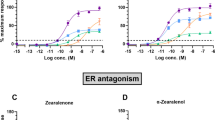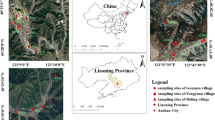Abstract
In the present study, re-combined estrogen receptor (ER) and androgen receptor (AR) gene yeast assays combined with a novel approach based on Monte Carlo simulation were used for evaluation and characterization of soil samples collected from Jilin along the Second Songhua River to assess their antagonist/agonist properties for ER and AR. The results showed that estrogenic activity only occurred in the soil samples collected in the agriculture area, but most soil samples showed anti-estrogenic activities, and the bioassay-derived 4-hydroxytamoxifen equivalents ranged from N.D. to 23.51 μg/g. Hydrophilic substance fractions were determined as potential contributors associated with anti-estrogenic activity in these soil samples. Moreover, none of the soil samples exhibited AR agonistic potency, whereas 54 % of the soil samples exhibited AR antagonistic potency. The flutamide equivalents varied between N.D. and 178.05 μg/g. Based on Monte Carlo simulation-related mass balance analysis, the AR antagonistic activities were significantly correlated with the media polar and polar fractions. All of these results support that this novel calculation method can be adopted effectively to quantify and characterize the ER/AR agonists and antagonists of the soil samples, and these data could help provide useful information for future management and remediation efforts.







Similar content being viewed by others
References
Alvarez-Muñoz D., Indiveri P., Rostkowski P., Horwood J., Greer E., Minier C., Pope N., Langston W.J., Hill E.M. (2014). Widespread contamination of coastal sediments in the transmanche channel with anti-androgenic compounds. Marine Pollution Bulletin, Available online.
Antos, P., Grzegorzewska, A., Hrabia, A., Blachuta, M., & Sechman, A. (2013). Antiestrogenic action of 2,3,7,8-tetrachlorodibenzo-p-dioxin (TCDD) in chicken ovarian follicles. Reproductive Biology, 13, 17.
Burns, C. J., Mclntosh, L. J., Mink, P. J., Jurek, A. M., & Li, A. A. (2013). Pesticide exposure and neurodevelopmental outcomes: review of the epidemiologic and animal studies. Journal of toxicology and environmental health. Part B. Critical Reviews, 16, 395–398.
Deblonde, T., Cossu-Leguille, C., & Hartemann, P. (2011). Emerging pollutants in wastewater: a review of the literature. International Journal of Hygiene and Environmental Health, 214, 442–448.
EDSTAC (1998). Endocrine Disruptor Screening and Testing Advisory Committee Final Report 1998, Available at: http://www.epagov/endo/pubs/edspoverview/finalrpthtm
Finlay-Moore, O., Hartel, P. G., & Cabrera, M. L. (2000). 17β-estradiol and testosterone in soil and runoff from grasslands amended with broiler litter. Journal of Environmental Quality, 29, 1604–1611.
Gaido, K. W., Leonard, L. S., Lovell, S., Gould, J. C., Babaï, D., Portier, C. J., & McDonnell, D. P. (1997). Evaluation of chemicals with endocrine modulating activity in a yeast-based steroid hormone receptor gene transcription assay. Toxicology and Applied Pharmacology, 143, 205–212.
Grung, M., Naes, K., Fogelberg, O., Nilsen, A. J., Brack, W., Lübcke-von, V. U., & Thomas, K. V. (2011). Effects-directed analysis of sediments from polluted marine sites in Norway. Journal of Environmental Science and Health Part A, 74, 439–454.
Hill, E. M., Evans, K. L., Horwood, J., Rostkowski, P., Oladapo, F. O., Gibson, R., Shears, J. A., & Tyler, C. R. (2010). Profiles and some initial identifications of (anti)androgenic compounds in fish exposed to wastewater treatment works effluents. Environmental Science and Technology, 44, 1137–1143.
Hoefling, M., Lima, N., Haenni, D., Seidel, C. A., Schuler, B., & Grubmüller, H. (2011). Structural heterogeneity and quantitative FRET efficiency distributions of polyprolines through a hybrid atomistic simulation and Monte Carlo approach. PloS One, 6, e19791.
Holbrook, R. D., Love, N. G., & Novak, J. T. (2004). Sorption of 17β-estradioland 17α-ethinylestradiol by colloidal organic carbon derived from biological wastewater treatment systems. Environmental Science and Technology, 38, 3322–3329.
Holbrook, R. D., Novak, J. T., & Love, N. G. (2005). Impact of activated sludge-derived colloidal organic carbon on behavior of estrogenic agonist recombinant yeast bioassay. Environmental Toxicology and Chemistry, 24, 2717–2724.
Jackson, J., & Sutton, R. (2008). Sources of endocrine-disrupting chemicals in urban wastewater, Oakland, CA. Science of the Total Environment, 405, 153–160.
Jálová, V., Jarošová, B., Bláha, L., Giesy, J. P., Ocelka, T., Grabic, R., Jurcikova, J., Vrana, B., & Hilscherová, K. (2013). Estrogen-, androgen- and aryl hydrocarbon receptor mediated activities in passive and composite samples from municipal waste and surface waters. Environment International, 59, 372–383.
Janosek, J., Bittner, M., Hilscherová, K., Bláha, L., Giesy, J. P., & Holoubek, I. (2007). AhR-mediated and antiestrogenic activity of humic substances. Chemosphere, 67, 1096–1101.
Jobling, S., Burn, R. W., Thorpe, K., Williams, R., & Tyler, C. (2009). Statistical modeling suggests that antiandrogens in effluents from wastewater treatment works contribute to widespread sexual disruption in fish living in English rivers. Environmental Health Perspectives, 117, 797–802.
Kharlyngdoh, J. B., Pradhan, A., Asnake, S., Walstad, A., Ivarsson, P., & Olsson, P. E. (2015). Identification of a group of brominated flame retardants as novel androgen receptor antagonists and potential neuronal and endocrine disrupters. Environment International, 74, 60–70.
Li, J., Ma, M., & Wang, Z. J. (2010). In vitro profiling of endocrine disrupting effects of phenols. Toxicology In Vitro, 24, 201–207.
Li, J., Chen, M., Wang, Z., Ma, M., & Peng, X. (2011). Analysis of environmental endocrine disrupting activities in wastewater treatment plant effluents using recombinant yeast assays incorporated with exogenous metabolic activation system. Biomedical and Environmental Sciences, 24, 132–139.
Liscio, C., Abdul-Sada, A., Al-Salhi, R., Ramsey, M. H., & Hill, E. M. (2014). Methodology for profiling anti-androgen mixtures in river water using multiple passive samplers and bioassay-directed analyses. Water Research, 57, 258–269.
Luo, J., Lei, B., Ma, M., Zha, J., & Wang, Z. (2011). Identification of estrogen receptor agonists in sediments from Wenyu River, Beijing, China. Water Research, 45, 3908–3914.
Ma, M., Rao, K. F., & Wang, Z. J. (2007). Occurrence of estrogenic effects in sewage and industrial wastewaters in Beijing, China. Environmental Pollution, 147, 331–336.
Ma, W. L., Liu, L. Y., & Qi, H. (2013). Polycyclic aromatic hydrocarbons in water, sediment and soil of the Songhua River basin, China. Environmental Monitoring and Assessment, 185, 8399–8409.
Mnif, W., Ibn Hadj Hassine, A., Bouaziz, A., Bartegi, A., Thomas, O., & Roig, B. (2011). Effect of endocrine disruptor pesticides: a review. International Journal of Environmental Research and Public Health, 8, 2265–2303.
National Environmetal Quality standards for Soils of China (GB15618, 1995)
Peakall, D. B. (2000). Review of books on endocrine disruptors. Ecotoxicology, 9, 137–144.
Putzrath, R. M. (1997). Estimating relative potency for receptor-mediated toxicity: reevaluating the toxicity equivalence factor (TEF) model. Regulatory Toxicology and Pharmacology, 25, 68–78.
Shi, W., Wei, S., Hu, X. X., Hu, G. J., Chen, C. L., Wang, X. R., Giesy, J. P., & Yu, H. X. (2013). Identification of thyroid receptor ant/agonists in water sources using mass balance analysis and Monte Carlo simulation. PloS One, 8, e73883.
Shore, L. S., Correll, D. I., & Chakraborty, P. K. (1995). Relationship of fertilization with chicken manure and concentrations of estrogens in small streams. In K. Steele (Ed.), Animal waste and the land-water interface (pp. pp. 155–pp. 163). Boca Raton, FL: CRC Press.
Sohoni, P., & Sumpter, J. P. (1998). Several environmental estrogens are also anti-androgens. Journal of Endocrinology, 158, 327–339.
Sun, H., Chen, W., Xu, X. L., Ding, Z., Chen, X. D., & Wang, X. R. (2014). Pyrethroid and their metabolite, 3-phenoxybenzoicacid showed similar (anti)estrogenic activity inhuman and rat estrogen receptor α–mediated reporter gene assays. Environmental Toxicology and Pharmacology, 37, 371–377.
Testai, E., Galli, C. L., Dekant, W., Marinovich, M., Piersma, A. H., & Sharpe, R. M. (2013). A plea for risk assessment of endocrine disrupting chemicals. Toxicology, 314, 51–59.
Van straalen, N. M. V., & Roelofs, D. (2008). Genomics technology for assessing soil pollution. Journal of Biology, 7, 19.
Wang, C., Feng, Y., Gao, P., Ren, N., & Li, B. L. (2012). Simulation and prediction of phenolic compounds fate in Songhua river, China. Science of the Total Environment, 431, 366–374.
Wölz, J., Grosshans, K., Streck, G., Schulze, T., Rastall, A., Erdinger, L., Brack, W., Fleig, M., Kühlers, D., Braunbeck, T., & Hollert, H. (2011). Estrogen receptor mediated activity in bankside groundwater, with flood suspended particulate matter and floodplain soil—an approach combining tracer substance, bioassay and target analysis. Chemosphere, 85, 717–723.
World Health Organization (2012). United Nations Environment Programme (WHO-UNEP), In: Bergman, A., Heindel, J.J., Jobling, S., Kidd, K.A., Zoeller, R.T.(Eds.), State of the Science of Endocrine Disrupting Chemicals. Available at: <http://www.who.int/ceh/publications/endocrine/en/index.html>
Wu, Q. Y., Hu, H. Y., Zhao, X., & Sun, Y. X. (2009). Effect of chlorination on the estrogenic/antiestrogenic activities of biologically treated wastewater. Environmental Science and Technology, 43, 4940–4945.
Wu, Q. Y., Tang, X., Huang, H., Li, Y., Hu, H. Y., Ding, Y. N., & Shao, Y. R. (2014). Antiestrogenic activity and related disinfection by-product formation induced by bromide during chlorine disinfection of sewage secondary effluent. Journal of Hazardous Materials, 273, 280–286.
Xing, Y., Lu, Y., Dawson, R. W., Shi, Y., Zhang, H., Wang, T., Liu, W., & Ren, H. (2005). A spatial temporal assessment of pollution from PCBs in China. Chemosphere, 60, 731–739.
Yamamoto, H., Liljestrand, H. M., Shimizu, Y., & Morita, M. (2003). Effects of physical-chemical characteristics on the sorption of selected endocrine disruptors by dissolved organic matter surrogates. Environmental Science and Technology, 37, 2646–2657.
Zhou, Y., Zha, J., Xu, Y., Lei, B., & Wang, Z. (2012). Occurrences of six steroid estrogens from different effluents in Beijing, China. Environmental Monitoring and Assessment, 184, 1719–1729.
Acknowledgments
This study was supported by the National Natural Science Foundation of China (41001351), the Fundamental Research Funds for the Central Universities (2012LYB35), and the Major Science and Technology Program for Water Pollution Control and Treatment (2014ZX07201-010).
Author information
Authors and Affiliations
Corresponding author
Electronic supplementary material
ESM 1
(DOC 410 kb)
Rights and permissions
About this article
Cite this article
Li, J., Wang, Y., Kong, D. et al. Evaluation and characterization of anti-estrogenic and anti-androgenic activities in soil samples along the Second Songhua River, China. Environ Monit Assess 187, 724 (2015). https://doi.org/10.1007/s10661-015-4933-4
Received:
Accepted:
Published:
DOI: https://doi.org/10.1007/s10661-015-4933-4




